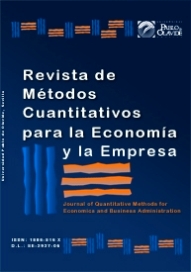A distribution rule for allocation problems with priority agents using the least square method
DOI:
https://doi.org/10.46661/rev.metodoscuant.econ.empresa.7575Keywords:
Allocation problems, Least-squares method, Priority agentsAbstract
We use the least-squares method for inconsistent systems to find a new allocation rule for rationing and surplus problems. In particular, we study allocation problems considering different priorities to satisfy the agents’ demands, which influence how the distribution is carried out. The new distribution rule is proposed by choosing different inner products defined in linear algebra and providing explicit formulas for assigning resources to the agents. Moreover, we illustrate how it can recover different allocation rules by adequately defining the priorities. As an application of the rationing problem with priority agents, we consider real data for allocating police officers in the states of Mexico. In this example, the agents represent the states of Mexico, and their priorities were established based on the criminal incidence. Also, we compute and compare the resource distribution given by classic allocation rules and the percentage of loss obtained with each one.
Downloads
References
Casella, G. and Berger, R. L. (2021). Statistical inference. Cengage Learning.
Cruze, N. B., Goel, P. K., and Bakshi, B. R. (2014). Revisiting least squares techniques for the purposes of allocation in life cycle inventory. The International Journal of Life Cycle Assessment 19(10), 1733-1744.
https://doi.org/10.1007/s11367-014-0771-9
Eldar, Y. C. (2002). Least-squares inner product shaping. Linear algebra and its applications 348(1-3),153-174.
https://doi.org/10.1016/S0024-3795(01)00575-4
Guerrero, F. M., Hinojosa, M. Á., and Sánchez, F. (2006). Teoría de juegos aplicada a problemas de bancarrota. Contribuciones a la Economía, (2006).
Herrero, C. (2003). Equal awards vs. equal losses: duality in bankruptcy. In Advances in economic design, Springer, Berlin, Heidelberg, pages 413-426.
https://doi.org/10.1007/978-3-662-05611-0_22
Hoffman, K., Kunze, R., and Finsterbusch, H. E. (1973). Álgebra lineal. Prentice-Hall Hispanoamericana.
INEGI (2021). Población total por entidad federativa y grupo quinquenal de edad según sexo, serie de años censales de 1990 a 2020. https://www.inegi.org.mx/app/tabulados/interactivos/?pxq=Poblacion_Poblacion_01_e60cd8cf-927f-4b94-823e-972457a12d4b idrt=123 opc=t. Accessed: 2023-08-01.
INEGI (2022a). Identifican déficit de más de 100,000 policas en el país. https://www.eleconomista.com.mx/politica/Identifican-deficit-de-mas-de-100000-policias-en-el-pais-20210504-0014.html. Accessed: 2023-08-01.
INEGI (2022b). Incidencia delictiva. https://www.inegi.org.mx/temas/incidencia. Accessed: 2023-08-01.
Lorenzo, L. (2010). The constrained equal loss rule in problems with constraints and claims. Optimization 59(5), 643-660.
https://doi.org/10.1080/02331930802180301
Margalit, D., Rabinoff, J., and Rolen, L. (2017). Interactive linear algebra. Georgia Institute of Technology.
Moulin, H. (2000). Priority rules and other asymmetric rationing methods. Econometrica 68(3), 643-684.
https://doi.org/10.1111/1468-0262.00126
Ólvera-López, W., Sánchez-Sánchez, F., and Tellez-Tellez, I. (2014). Bankruptcy problem allocations and the core of convex games. Economics Research International 2014, 517951.
https://doi.org/10.1155/2014/517951
O'Neill, B. (1982). A problem of rights arbitration from the talmud. Mathematical social sciences 2(4), 345-371.
https://doi.org/10.1016/0165-4896(82)90029-4
Strutz, T. (2011). Data fitting and uncertainty: A practical introduction to weighted least squares and beyond. Springer.
https://doi.org/10.1007/978-3-8348-9813-5
Thomson, W. (2003). Axiomatic and game-theoretic analysis of bankruptcy and taxation problems: a survey. Mathematical social sciences 45(3), 249-297.
https://doi.org/10.1016/S0165-4896(02)00070-7
Secretaría de Seguridad y Protection Ciudadana Diario Oficial (2021). Modelo nacional de policía y justicia cívica. https://www.gob.mx/cms/uploads/attachment/file/542605/DOC_1._MODELO_NACIONAL_DE_POLIC_A_Y_JC.pdf, Last accessed on 2017-11-30.
Published
How to Cite
Issue
Section
License
Copyright (c) 2023 Julio César Macías Ponce, Arturo Enrique Giles Flores, Sandra Elizabeth Delgadillo Alemán, Roberto Alejandro Kú Carrillo, Luz Judith Rodríguez Esparza

This work is licensed under a Creative Commons Attribution-ShareAlike 4.0 International License.
Submission of manuscripts implies that the work described has not been published before (except in the form of an abstract or as part of thesis), that it is not under consideration for publication elsewhere and that, in case of acceptance, the authors agree to automatic transfer of the copyright to the Journal for its publication and dissemination. Authors retain the authors' right to use and share the article according to a personal or instutional use or scholarly sharing purposes; in addition, they retain patent, trademark and other intellectual property rights (including research data).
All the articles are published in the Journal under the Creative Commons license CC-BY-SA (Attribution-ShareAlike). It is allowed a commercial use of the work (always including the author attribution) and other derivative works, which must be released under the same license as the original work.
Up to Volume 21, this Journal has been licensing the articles under the Creative Commons license CC-BY-SA 3.0 ES. Starting from Volume 22, the Creative Commons license CC-BY-SA 4.0 is used.










